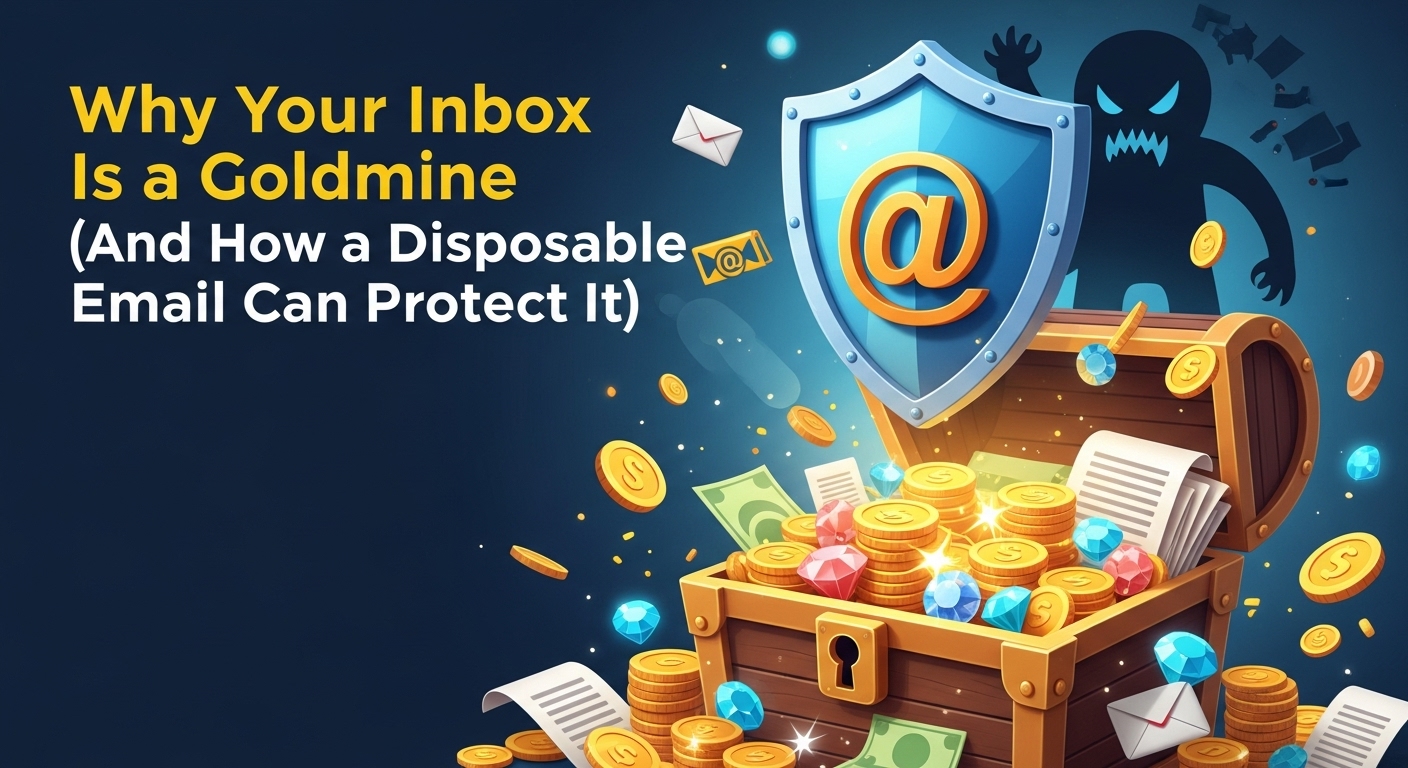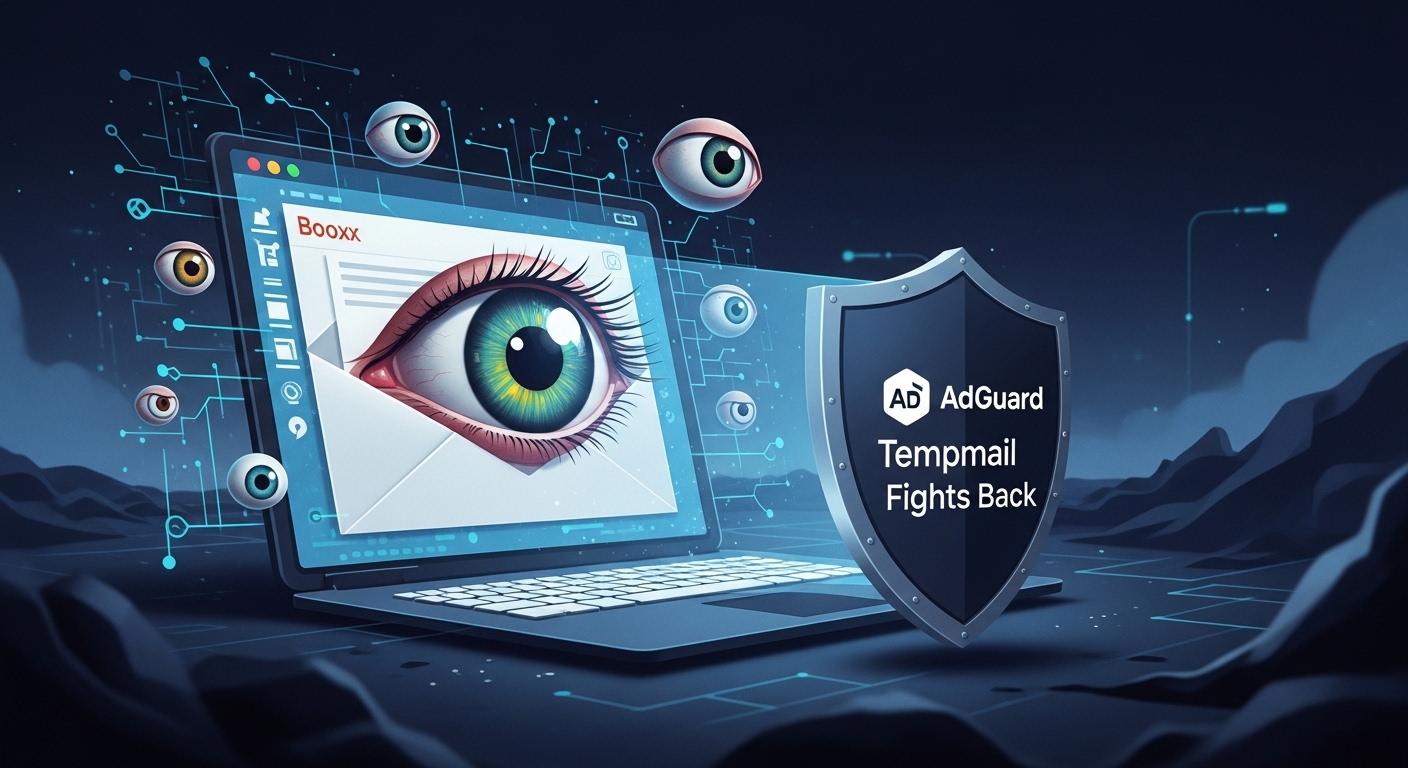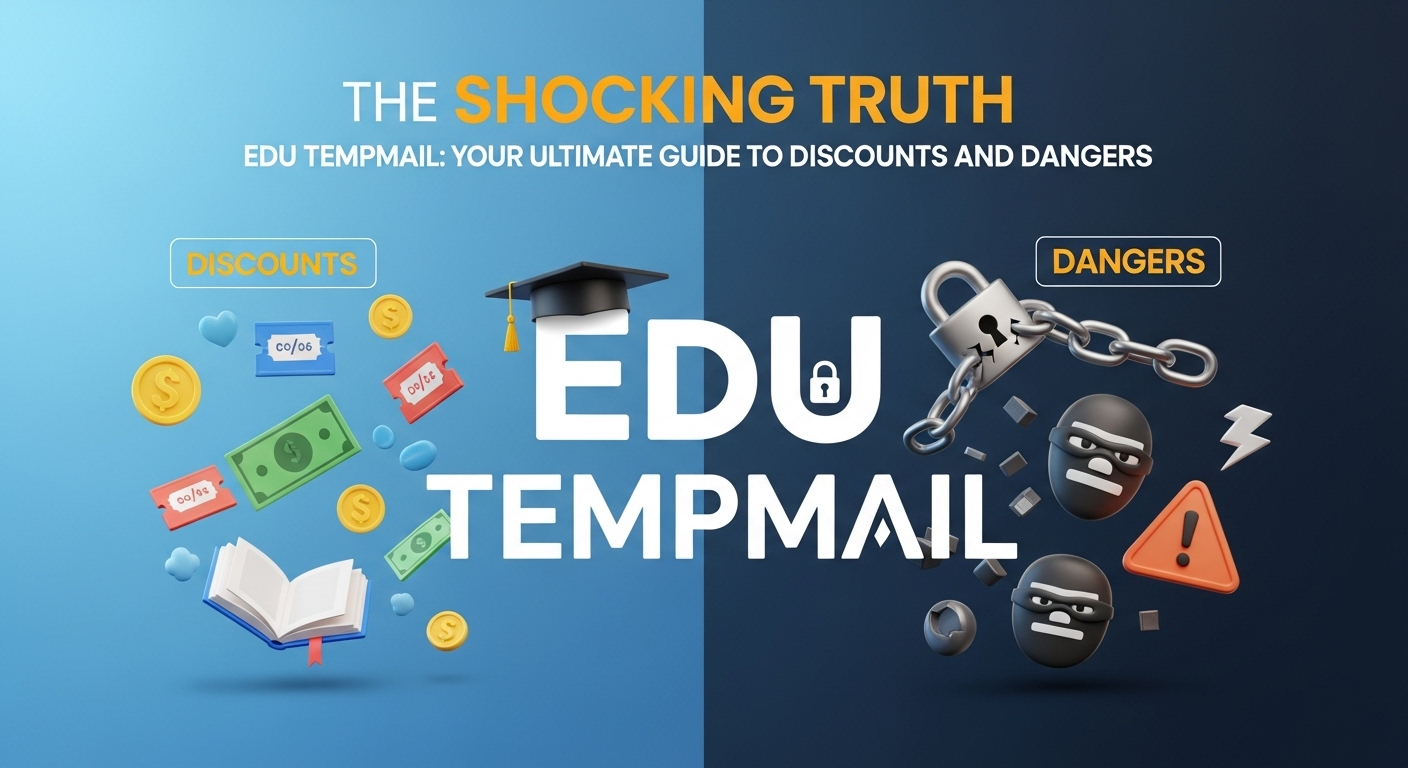Why Your Inbox Is a Goldmine (And How a Disposable Email Can Protect It)

Your digital front door is wide open. Every day, a staggering 376.4 billion emails fly across the globe. The shocking part? Nearly half of that—a colossal 47%—is spam. This isn't just a minor annoyance; it's a constant siege on our digital lives.
This flood of junk mail is the smokescreen for a much larger threat: data breaches. The average cost of a data breach reached an all-time high of $4.88 million in 2024, and these incidents often start with a single compromised email address. Your inbox isn't just a mailbox; it's a target for marketers, data brokers, and cybercriminals.
But what if you had a secret weapon? A simple, free tool to fight back against this digital chaos. This is where the disposable email comes in—your personal shield in the battle for your inbox.
What is a Disposable Email? Your Secret Weapon Against Digital Clutter
A disposable email address (DEA) is a temporary, throwaway email account designed for short-term use. It’s created to receive an email, often for a verification link or a one-time download, and then it self-destructs after a certain period. All messages in its inbox vanish along with it.
You might hear it called by many names, all pointing to the same clever concept:
Temp mail
10-minute mail
Throwaway email
Burner mail
Fake mail
Trash-mail
Think of it like a digital sticky note. You jot down a temporary piece of information, use it, and then toss it in the trash. There's no long-term commitment and no clutter left behind.
How Does a Disposable Email Actually Work?
The beauty of a disposable email is its simplicity. The process is incredibly fast and requires no personal information, keeping you completely anonymous.
Here’s the typical process:
Visit a Provider: Go to a disposable email service's website.
Get Your Address: The service instantly generates a random, active email address for you. No sign-up, no password, no hassle.
Copy and Use: Copy the temporary address and paste it into any online form that asks for your email.
Check Your Mail: Return to the provider’s website. Any emails sent to the address will appear in a temporary inbox right on the page.
Walk Away: Once you have what you need, simply close the browser tab. The address and its contents will disappear forever after a set time.
Watch this short video to see just how easy it is:
The standard internet model is built on permanence. Data is stored forever, creating a digital footprint that can be exploited years later. A disposable email challenges this by making its short lifespan its greatest strength. In a world where data is permanent, the power to be forgotten is a powerful form of protection.
The Unbeatable Benefits of Using a Temporary Email Address
Using a temporary email address is a proactive security measure. Instead of cleaning up a messy inbox, you prevent it from getting cluttered in the first place. This simple shift in strategy offers several powerful advantages.
Bulletproof Spam Protection: This is the number one reason people use a disposable email. By using a temporary address for sign-ups, you create a barrier that protects your real inbox from the endless flood of marketing lists and junk mail. Your main inbox stays clean and reserved for the communications that actually matter to you.
Fortify Your Online Privacy: Every time you share your real email, you're creating a link between your activity on that site and your core digital identity. A disposable email breaks this link. It prevents companies from building detailed profiles on you and tracking your behavior across the web, giving you back control over your digital privacy.
Safely Explore the Web: Want to download a free e-book, get a discount code, or try a new service without committing? A burner mail account is the perfect tool. You get the one-time benefit without the long-term consequence of being added to yet another newsletter you'll never read.
Isolate Security Breach Risks: In 2025, over half of all data breaches involved customer personally identifiable information (PII), including emails. If a service you signed up for with a disposable email gets hacked, your primary email and other accounts remain completely safe. The breach is contained to a digital dead end, protecting you from the fallout.
When to Use a Disposable Email:
The power of a disposable email lies in knowing when to use it. It's the perfect tool for the internet's many brief, transactional exchanges—where you need something from a website but don't want to establish a permanent relationship.
Here are seven practical situations where a temp mail is your best friend:
Online Shopping & Coupon Hunting: Use a disposable email to grab that "15% off your first order" coupon. You get the discount without signing up for a lifetime of daily promotional emails that clog your inbox.
Signing Up for Free Trials: Test out that new software or streaming service without worry. If you decide not to subscribe, you won't be bombarded with follow-up marketing or "we miss you" emails.
Commenting on Blogs or Forums: Participate in online discussions without exposing your primary email address on public forums, where it can be easily scraped by spam bots.
Downloading Gated Content: Get immediate access to that free PDF, whitepaper, or webinar recording without being forced into an aggressive marketing funnel you never asked for.
Testing & Development: For developers and Quality Assurance testers, disposable emails are invaluable. They allow you to create multiple test accounts to check registration flows and email functionalities without using real user data or cluttering personal inboxes.
Social Media Sign-ups: Create a secondary social media account or sign up for a new platform you're unsure about. This keeps the new account separate from your primary digital identity.
Online Dating: When you first start communicating with potential matches on dating apps or sites, using a temporary email adds a crucial layer of privacy and safety. You can communicate freely until you feel comfortable sharing more personal details.
Top Disposable Email Providers of 2025:
Dozens of services offer disposable email addresses, but a few stand out for their reliability and ease of use. For users seeking a straightforward and reliable service, options like (https://temptomail.org) provide a clean, user-friendly interface to generate a temporary email in seconds, embodying the core principles of simplicity and privacy.
Here’s a look at some of the top providers:
(https://temp-mail.org/): One of the most popular choices, known for its extreme simplicity. It provides a persistent (but still temporary) address and offers premium features like custom domains for users who need more control.
10 Minute Mail: The name says it all. This service is perfect for ultra-fast, time-sensitive tasks. It gives you an email address that self-destructs in just 10 minutes, though you can extend the timer if you need more time.
Guerrilla Mail: A feature-rich option that has been around for years. It allows you to not only receive but also send emails from your temporary address and even attach large files, a rare feature in the disposable email world.
(https://www.emailondeck.com/): Known for its simple two-step process and focus on security. For privacy purists, it even accepts(https://bitcoin.org/en/) for its pro version, allowing for more anonymous transactions.
To help you choose the right tool for the job, here is a quick comparison of the leading services.
| Service Name | Key Feature | Lifespan | Anonymity Level | Best For |
|---|---|---|---|---|
| Temp Mail | Simple interface, premium options | Varies (until deleted/domain change) | High | General purpose, beginners |
| 10 Minute Mail | Self-destructs in 10 minutes | 10 minutes (extendable) | Very High | Quick verifications, one-time use |
| Guerrilla Mail | Can send emails, scrambled address | 1 hour (auto-deletes) | High | Sending anonymous replies, attachments |
| EmailOnDeck | Secure, 2-step process | A few hours (variable) | High | Privacy-focused users, crypto payments |
| (https://temptomail.org) | Clean & modern interface | Temporary | High | Simple, fast, and reliable generation |
Disposable Email vs. Email Alias: What's the Smart Choice for You?
When exploring privacy tools, you'll often hear "email alias" mentioned alongside "disposable email." They sound similar, but they serve fundamentally different purposes. Choosing the wrong one can lead to major headaches.
Disposable Email: A temporary, separate inbox that is completely independent and self-destructs. It's for things you want to throw away.
Email Alias: A permanent, forwarding address that directs emails to your real inbox. It's a mask for your primary email, not a separate account. It's for things you want to keep but organize. For example, an alias like shopping.username@mydomain.com can be set up to forward all messages to your main username@mydomain.com inbox.
This table breaks down the key differences to help you decide which tool fits your needs.
| Feature | Disposable Email | Email Alias |
|---|---|---|
| Duration | Temporary (minutes to hours) | Permanent (until you delete it) |
| Inbox | Separate, public, web-based | Your main, private inbox |
| Security | Low (often public, no password) | High (uses your main account's security) |
| Primary Use Case | One-time sign-ups, untrusted sites | Long-term sign-ups, organizing subscriptions |
| Account Recovery | Impossible | Yes, through your main account |
| Sending Email | Limited or not supported | Yes, often can reply from the alias |
Conclusion:
Your email address is one of the most valuable pieces of your digital identity. It's the key to your social media accounts, your online shopping profiles, and countless other services. Leaving it unprotected is like leaving your front door unlocked.
A disposable email is one of the simplest and most effective tools you can use to protect it. It's the perfect solution for the thousands of low-stakes, temporary online interactions that don't require a permanent connection. It gives you unparalleled protection against spam, data clutter, and privacy invasion.
Don't let your inbox be a product for sale. Start using these tools today and build a more private, secure digital life.
Frequently Asked Questions (FAQ) About Disposable Emails
1. What is the main purpose of a disposable email?
Its main purpose is to protect your primary email from spam, marketing lists, and potential data breaches. You use it for temporary or low-trust online interactions where you need an email for verification but don't want to reveal your real one.
2. Are disposable emails legal to use?
Yes, using a disposable email address is perfectly legal for legitimate purposes like protecting your privacy and avoiding spam. However, using them to engage in illegal activities or violate a website's terms of service is, of course, prohibited.
3. How long does a temporary email last?
The lifespan varies by provider. Some, like 10 Minute Mail, last only 10 minutes (though this can be extended). Others may last for a few hours or until the service provider changes its list of available domains.
4. Can I send emails from a disposable address?
Most services are receive-only. However, a few providers like Guerrilla Mail are more advanced and do allow you to compose and send emails from the temporary address.
5. Are disposable emails truly anonymous?
They provide a high degree of anonymity because they don't require any personal information to create. However, they are not completely untraceable. Many services may log your IP address, and the inboxes themselves are often not password-protected. For true anonymity, you would need to use them with other privacy tools like a VPN.
6. Will websites block disposable emails?
Yes, this is becoming more common. Many larger websites and online services maintain blacklists of known disposable email domains to prevent fraud and abuse. If you use an address from a well-known provider, your sign-up may be rejected.
7. Is it safe to use a temporary email for social media like Facebook?
It's risky. You can use it for the initial sign-up, but if you ever get locked out of your account or forget your password, you will have no way to receive a reset link. This means you could lose access to your account permanently.
8. Can I recover a disposable email once it expires?
No. Once a disposable email address expires, it and all of its contents are permanently deleted. There is no way to recover the address or any emails that were sent to it.
9. What is the difference between a disposable email and a Gmail alias?
A disposable email is a completely separate, temporary inbox provided by a third-party service. A Gmail alias (e.g., myname+shopping@gmail.com) is not a separate account; it's just a label that directs email to a specific folder within your main Gmail inbox. It helps with filtering but still exposes your core account name.
10. Should I use a disposable email for online banking or shopping?
Absolutely not for banking or any financial service. The lack of security makes this incredibly dangerous. For shopping, it's fine to use for a one-time purchase to get a coupon code, but you should not use it to create a permanent customer account where you'll need access to order history, receipts, or customer support.
11. Do I need to pay for a disposable email service?
No, the vast majority of disposable email services are completely free to use. Some providers, like(https://temp-mail.org/), offer premium paid plans that include extra features like custom domains, no ads, and additional storage, but the core functionality is free.
12. How do disposable email services make money if they are free?
Most free services are supported by on-site advertising. This is the primary revenue model. Some also generate income by offering premium, subscription-based tiers with advanced features for users who need more than the basic service provides.
For further reading on this topic, we recommend the excellent guide from(https://www.techradar.com/best/best-temporary-email-service).
Please don’t forget to leave a review of my article.
You Might Also Like
Is Your Inbox Spying on You? Here’s How AdGuard Tempmail Fights Back
Have you ever paused before entering your email address into a new website, feeling a slight hesitation? That feeling is...

The Shocking Truth About Edu Tempmail: Your Ultimate Guide to Discounts and Dangers
Imagine getting over 60% off Adobe Creative Cloud and half-price Amazon Prime. What if you could get those deals without...

Why Your Hotmail Is a Privacy Nightmare (And How Temp Mail Can Save You)
Did you know that nearly half of all emails sent worldwide are spam? In 2024, spam accounted for a staggering 47.27% of ...

The Ultimate Deception: Is Tempmail Safe, or a Ticking Time Bomb?
Your email inbox is more than just a place for messages. It's the digital key to your entire online life. Every password...

The Ultimate Betrayal: How Your Inbox Is Selling You Out (And How to Use Tempmail to Stop It)
Your inbox is a battlefield. Every single day, a war is waged for your attention, your data, and your money. Don't belie...

Your Digital Shield: The Astonishing Truth About How Temp Mail Works
Opening your email inbox can feel like walking into a battlefield. You’re constantly dodging a barrage of promotional ju...

